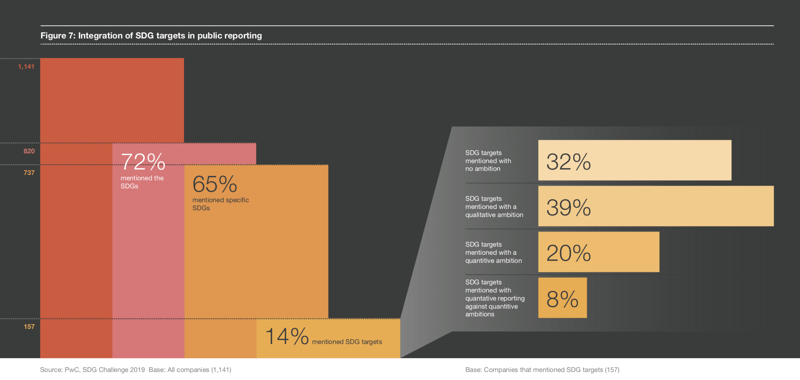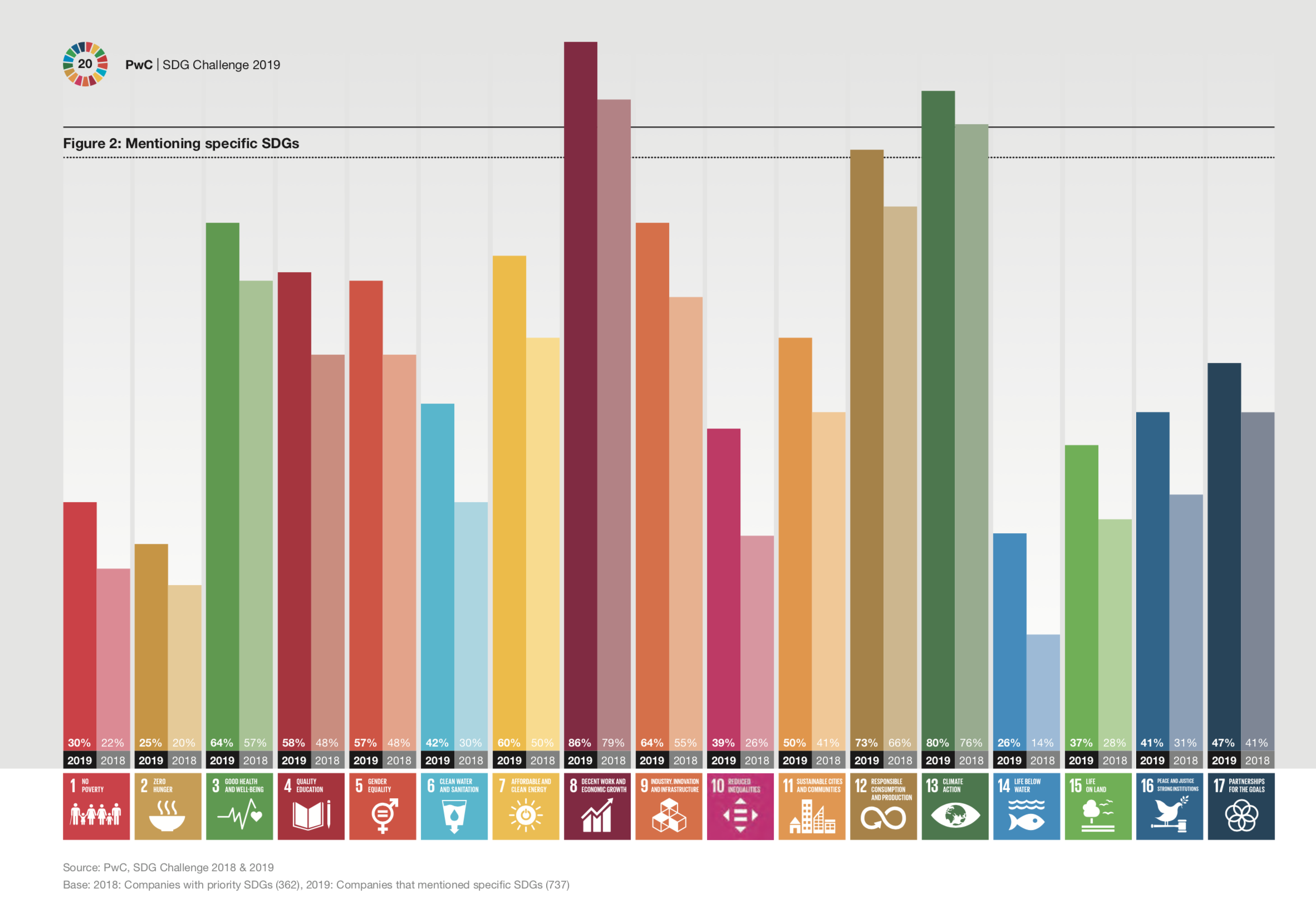PwC recently published their latest Sustainability Challenge report for 2019. It covers an analysis of 1,141 companies in 31 countries and across 7 industries. Along with insights, the report includes concrete steps on how to leverage the SDG framework in order to most effectively tackle global challenges and capitalize on the business opportunities they provide.
Check out this summary we made for you – save some time and know what to focus on to better leverage the SDGs.
Why are the SDGs so important?
Besides helping organizations manage risk and encourage innovation, the SGDs provide each stakeholder with specific advantages. First off, they help companies benchmark themselves and track progress through a uniform framework understood and used by a variety of stakeholders. In so doing, companies can evaluate their business strategy in a standardized way and respond to fast-changing consumer demands regarding their wider ESG impact.
Governments, on the other hand, can better understand a company’s net sustainability impact and know whether it can maintain its license to operate. Similarly, investors want to keep track of their portfolio's Economic, Social, and Governance (ESG) impact through a standardized framework to help make informed decisions.
Key findings from Sustainability Challenge Report
In the study, 72% of companies in 2019 considered in the report publicly mention the SDGs in their reports/publications. So, there’s a good level of business awareness about the framework.
In addition, 21% of companies mention the SDGs in the CEO or Chair statement, a 13% increase from the year before. This shows that the goals are moving to the top of the executive agenda thanks to regulation, pressure from investors, and future-focused strategy. However, only 14% mentioned specific SDG targets and very few reported on progress towards these targets. Only 8% provided quantitative measures of progress.

Countries that topped the list with the most companies committed to the SDGs are Colombia, Sweden, Denmark, The Netherlands, France, and the UK. This high level of commitment may be correlated to more government engagement in these countries.
Of the seven industry sectors considered, financial services (74%) led the pack while the health sector was the least likely to mention the SDGs.
Which Sdgs were the most and least popular in 2019?
The SDGs that were most and least popular according to this sample group reflects the notion that companies pick SDGs most in line with their largest area of impact. This explains why SDG8 tops the charts, since companies view creating and preserving jobs as a priority. According to PwC’s Sustainability Challenge report, the most popular SDGs in 2019 were:
- Decent Work and Economic Growth (SDG8)
- Responsible Consumption and Production (SDG12)
- Climate Action (SDG13)
In contrast, the least popular SDGs for businesses were:
- Zero Hunger (SDG2)
- Life Below Water (SDG14)
- No Poverty (SDG1)
Since 44% of the companies included from the study were from the Energy, utilities & mining and Industrial manufacturing & automotive industries, it's normal that SDG12 ranks highly while SDG2 may not, considering the former may align more closely with their business impact.

4 Concrete tips to implement the SDGs
With the latest data, the Sustainability Challenge report gives concrete tips to help you implement the SDGs as part of your core business strategy. Check out the 4 ways to make SDG implementation effective:
1. Have management incorporate the SDGs with business-specific activities
Understanding precisely which targets are relevant to specific business activities allows management to use them in order to set the company’s own internal business-relevant targets. When these targets are used as performance indicators to measure and report on progress, it drives the company to work towards the SDGs more comprehensively.
2. Create business buy-in from all stakeholders.
After linking the SDGs to business strategy, it’s important that leadership also talks about the business’ social, environmental and financial issues and the efforts that are undertaken to meet the goals set. Consider the effects your business activities have through the entire value chain and set targets that address both short-term impact and long-term change. Then, make sure to communicate about the risk of being left behind if the SDGs aren’t adopted. By aligning top-level leadership’s remuneration incentives with SDG targets, they effectively become a priority.
3. Focus only on goals where you have the highest impact
A great way to make the SDGs relevant to your business is to choose to focus on individual goals where your industry or business makes the biggest impact.
Companies prefer setting SDGs that cover their entire value chain, which means they tend to choose more SDGs to focus on. Companies mention an average of 9 SDGs that they work towards. This number is considerably high since only 34% of companies cited their SDGs in their business strategy. How is a business supposed to achieve nine goals if they’re not a part of a company’s core business? Make sure to use this golden opportunity to align new business opportunities with these areas of impact.
4. Breakdown the SDG goals into concrete targets to work towards
Choose relevant SDG targets to work towards under the goals you’ve set. Don’t measure against all 169 targets. For example, a company activity may have an obvious impact on Clean Water and Sanitation (SDG6), but only one of the six targets for this goal – 6.4 “substantially increase water-use efficiency” – is relevant.
Hopefully, these insights and concrete ways to implement the SDGs inspire you to take action today. Need help? Worldfavor's platform makes it easier for you to manage and report your sustainability information in order to reach your SDGs. Get in touch with us to learn more.








%20as%20the%20deadline%20approaches.%20Learn%20about%20compliance%20requirements%2c%20potential%20delays%2c%20and%20key%20updates..png)

